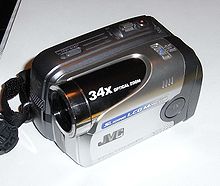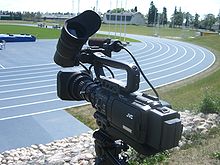- JVC
-
JVC
日本ビクター株式会社
Type Subsidiary Industry Electronics Founded Yokohama, Japan (1927) Headquarters Yokohama, Japan Key people Kunihiko Sato, President Products Audio, visual, computer-related electronics and software, media products Revenue  ¥658.4 billion (Fiscal year ended March 31, 2008)[1]
¥658.4 billion (Fiscal year ended March 31, 2008)[1]Employees 19,044 (Consolidated, as of March 31, 2008) Parent JVC Kenwood Holdings Subsidiaries Victor Entertainment Website JVC Global Victor Company of Japan, Ltd (日本ビクター株式会社 Nippon Bikutā Kabushiki-gaisha) (TYO: 6792), usually referred to as JVC, is a Japanese international consumer and professional electronics corporation based in Yokohama, Japan which was founded in 1927. The company is best known for introducing Japan's first televisions, and developing the VHS video recorder.
Contents
History
1920s creation to World War II
JVC was founded in 1927 as "The Victor Talking Machine Company of Japan, Limited," a subsidiary of the United States' leading phonograph and record company, the Victor Talking Machine Company. In 1929 majority ownership was transferred to RCA-Victor. In the 1930s JVC produced phonographs and records. In 1932 JVC started producing radios and in 1939 Japan's first locally made television. JVC severed relations with its foreign partners during World War II.
Post-war
In 1953, JVC became majority owned by [Panasonic Corporation|Matsushita] (Panasonic Corp).
In 1970, JVC marketed the Videosphere, a portable CRT television inside a space helmet-shaped casing with an alarm clock at the base. It was a commercial success.
In 1971, JVC introduced the first discrete system for four channel quadraphonic sound sound on vinyl records - CD-4 (Compatible Discrete Four Channel) or Quadradisc, as it was called by RCA in the US. In 1976 JVC introduced the 3060, a 3" portable television with an included cassette player.
The 1970s, 1980s and the VHS / Betamax format war
In the late 1970s JVC developed the VHS format, introducing the first VHS recorders to the consumer market in 1977 for the equivalent of US $1060. Sony, which had introduced the Betamax home videocassette tape a year earlier, became the main competitor for JVC's VHS format into the 1980s, creating the videotape format war. The Betamax cassette was smaller with slightly superior quality to the VHS cassette[citation needed], but this resulted in Betamax having less recording time. The two companies competed fiercely to encourage others to adopt their format, but by 1984 forty companies were using JVC's VHS format, while only 12 used Betamax. Sony began producing VHS recorders in 1988 and later stopped making Betamax recorders completely.
Other notable achievements
In 1979, JVC demonstrated a prototype of its VHD/AHD disc system. This system was capacitance-based like CED, but the discs were grooveless with the stylus being guided by servo signals in the disc surface. The VHD discs were initially handled by the operator and played on a machine that looked like an audio LP turntable, but JVC used caddy housed discs when the system was marketed. Development suffered numerous delays, and the product was launched in 1983 in Japan, followed by the UK in 1984 to a limited industrial market. By this time both Philips and Sony already had compact discs on the market, and the VHD format never caught on.
In 1981, JVC introduced a line of revolutionary direct drive cassette decks, topped by the DD-9, that provided previously unattainable levels of speed stability.
During the 1980s JVC briefly marketed its own portable audio equipment similar to the Sony Walkmans on the market at the time. The JVC CQ-F2K was released in 1982 and had a detachable radio that mounted to the headphones for a compact, wire-free listening experience. JVC had difficulty making the products successful, and a few years later stopped making them. In Japan, JVC marketed the products under the name Victor.
In 1986, JVC released the HC-95, a personal computer with a 3.58 MHz Zilog Z80A processor, 64KB RAM, running on MSX Basic 2.0. It included two 3.5" floppy disk drives and conformed to the graphics specification of the MSX-2 standard. However, like the Pioneer PX-7 it also carried a sophisticated hardware interface that handled video superimposition and various interactive video processing features. The JVC HC-95 was first sold in Japan, and then Europe, but sales were disappointing.
JVC video recorders were marketed by Ferguson in the UK, with just cosmetic changes. However Ferguson needed to find another supplier for its camcorders when JVC produced only the VHS-C format, rather than video8. Ferguson was later acquired by Thomson SA, which ended the relationship. JVC later invented hard drive camcorders.
In 2008 it became JVC Kenwood Holdings after Panasonic (Matsushita) decided to spin off the company and it merged with Kenwood Electronics.
Recent history
In October 2001, the National Academy of Television Arts and Sciences presented JVC an Emmy Award for "outstanding achievement in technological advancement" for “Pioneering Development of Consumer Camcorders.” Annual sponsorships of the world-renowned JVC Tokyo Video Festival and the JVC Jazz Festival have helped attract the attention of more customers.
JVC has been a worldwide football supporter since 1982, having a former kit sponsorship with Arsenal and continued its role as an official partner of 2002 FIFA World Cup Korea / Japan. JVC made headlines as the first-ever corporate partner of the Kennedy Space Center Visitor Complex. JVC has recently forged corporate partnerships with ESPN Zone and with Foxploration. In 2005, JVC joined HANA, the High-Definition Audio-Video Network Alliance to help establish standards in consumer electronics interoperability.
JVC developed the first DVD+RW DL in 2005.
In December 2006, Matsushita entered talks with Kenwood and Cerberus Capital Management to sell its stake in JVC.[2]
In 2007, Victor Company of Japan Ltd confirmed a strategic capital alliance with Kenwood and SPARKX Investment, resulting in Matsushita's holding being reduced to approx 37%.[3]
In 2008, Matsushita (Panasonic) agreed to spin-off the company and merge it with Kenwood Electronics, creating JVC Kenwood Holdings, formed on October 1, 2008.[4]
Sponsorship
JVC is a well known brand among English football fans due to the firm's sponsorship of Arsenal Football Club from 1981 to 1999, when Sega took over as Arsenal's sponsors. JVC's 18-year association with Arsenal is one of the longest club-sponsor associations with any professional club football.
JVC also sponsors the away shirts of the Australian A-League club, Sydney FC, and Dutch race driver Christijan Albers.
Brand name
JVC is generally known within Japan by the Victor brand, preceded by the His Master's Voice logo featuring the dog Nipper, but can use this logo only inside Japan. The company at time used the Nivico name (for "Nippon Victor Company") overseas. Therefore, the http://www.victor.jp and http://www.jvc-victor.co.jp/english/global-e.html web sites look quite different. Conversely, the HMV store chain exists in Japan (though no longer owned by HMV Group), but it cannot use the His Master's Voice motto or logo; its logo is a stylized image of a gramophone.[5]
Worldwide companies
- JVC America Inc. - Tuscaloosa, US
- JVC Americas Corp - Wayne, US
- JVC Canada Inc. - Toronto, Canada
- JVC Asia - Singapore
- JVC Australia - Australia
- JVC Europe - United Kingdom
- JVC China - China
- JVC Middle-East - Dubai, UAE
- JVC Latin America, S.A.' - Panama
- JVC do Brasil Ltda. - Brazil
- JVC International - Austria
- Victor Entertainment
See also
- List of digital camera brands
- List of home computers
- Mitsubishi Electric
- Video
- Wondermega
- XRCD
References
- ^ "Annual Report 2008 Financial Section for JVC". JVC Kenwood Holdings, Inc.. http://www.jk-holdings.com/en/ir/library/annual/data/jkh_ar_2008_en_fs_jvc.pdf. Retrieved 2010-05-19.
- ^ "Matsushita Says No Decision on Sale of Victor Shares to Kenwood". Bloomberg. 2006-12-23. http://www.bloomberg.com/apps/news?pid=20601101&refer=japan&sid=a.FYoVTCPXMY. Retrieved 2010-05-19.
- ^ "Kenwood, JVC Take First Merger Steps". TWICE. 2007-08-06. http://www.twice.com/article/239266-Kenwood_JVC_Take_First_Merger_Steps.php. Retrieved 2010-05-19.
- ^ Takenaka, Kiyoshi (2008-05-12). "JVC, Kenwood to merge under holding company". Reuters. http://www.reuters.com/article/idUST23591020080512. Retrieved 2010-05-19.
- ^ HMV Japan website
External links
 Media related to JVC at Wikimedia CommonsCategories:
Media related to JVC at Wikimedia CommonsCategories:- Companies listed on the Tokyo Stock Exchange
- Audio equipment manufacturers
- Companies established in 1927
- Companies based in Yokohama
- Electronics companies of Japan
- Electronics companies
Wikimedia Foundation. 2010.




